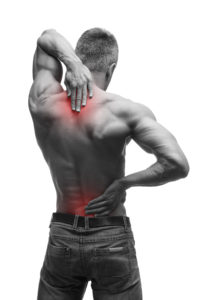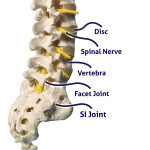Anyone can suffer from back pain, even children and teens, which makes it one of the most common painful conditions that people will suffer from at least once in their lifetime. It is also a common reason that people are absent from work, miss important life experiences, and end up seeking professional help. The pain can range from acute pain to chronic pain. Acute pain usually begins suddenly and lasts anywhere from a few weeks to months. This pain is usually brought on by a specific reason and can be treated easily with at home self-care. Chronic pain is pain that lasts longer than three months. It can be severe and debilitating for individuals that suffer from this pain. The condition is a different experience for every individual but there are common symptoms including: aching muscles, shooting or stabbing pain, pain radiating down the legs, pain that worsens when in an upright position (standing, walking, bending), and pain relief when resting/reclining.

Commonly Linked Conditions
Arthritis
Arthritis can develop in the spine causing spinal stenosis or narrowing of the spinal cord. Osteoarthritis, one of the most common types of arthritis, can lead to lower back pain and worsens with age.
Muscle or Ligament Strain
The pain is commonly brought on by repeated heavy lifting or sudden awkward movements. Being in poor physical condition while stressing your back can cause painful muscle spasms.
Bulging or Ruptured Discs
Located on your spine, discs are like cushions in between your bones (vertebrae). These discs are filled with a soft material that can leak from a tear in the disc and press on a nerve in the spine. When this occurs it can cause tingling, numbness, and even moderate to severe pain.
Irregular Spine
The most common condition for irregular spines is scoliosis. Scoliosis is when the spine curves to the side.
Osteoporosis
Osteoporosis is a condition in which your bones become weak and brittle causing the development of compression fractures in your spine.
When Should I See a Doctor?
If you have concerns about your pain, there is no harm in consulting your doctor whenever you feel it is necessary. For acute pain, your doctor can help give advice on some at home treatments. If your pain is not relieved by self-care and lasts longer than 3 weeks, it is time to seek professional help. Here are some signs that can help determine if you need to see a doctor.
- Pain is not improving
- Pain is severe and/or getting worse
- Pain is not relieved when resting
- Pain spreads to your legs, especially below your knees
- Weakness in one or both legs
- Tingling and/or numbing feelings in one or both legs
- Unexplained weight loss
If you experience any of these symptoms or signs with your pain, seek attention immediately:
- New bowel or bladder problems
- Fever
- Injury to your back
Risk Factors & Preventions
The most common risk factors for back pain are:
Age
The risk of suffering from this condition increases along with age. While it can occur in any age group, the most common age people begin to suffer from it begins around the 30s and 40s. It is helpful to be aware of your body. Figuring out how your body works and the best ways you can improve your health can help prevent future pain.
Exercise
Not exercising can cause your muscles to become weak. When the muscles in your back and abdominal become weak, it can cause your spine to become unbalanced. Exercising these muscles will allow your back to become stronger and function better overall. Low-impact aerobic activities, like walking or swimming, can help prevent and manage pain.
Weight
Being overweight causes extra stress on your back. Maintaining a healthy body weight can greatly reduce the chances of this condition.
Diseases
Certain diseases like arthritis and cancer can cause various symptoms, including back pain. While diseases like these can’t necessarily be prevented, it’s important to know how you can manage any pain they might cause.
Posture & Lifting
Incorrect posture and heavy lifting are some of the main causes of this condition. It’s important to remember to keep your posture correct to avoid future pain. Here are a few ways to avoid future pain:
- Standing without slouching, twisting, or straining your back.
- Changing sitting positions every 30 minutes while keeping your knees and hips aligned.
- Avoid heavy lifting but if not possible, lifting with a straight back and only bending at the knees.
Smoking
Studies show that smoking can worsen or even intensify your pain and also slows down your bodies healing process. It can reduce your blood flow, which means that your body and especially spine do not get all of the nutrients it needs to keep you healthy and strong. Quitting smoking can be difficult but can greatly improve your quality of life.
How Alabama Pain Physicians Can Help
At Alabama Pain Physicians, our goal is to better the quality of life of our patients. We take your pain seriously and strive to establish an accurate diagnosis along with a treatment plan to ultimately minimize your pain. To determine the exact cause of your pain, our physicians will perform a physical exam and use your complete medical history to help find the best treatment option suited for you. In addition to the physical exam and history, you may also need imaging studies and test to help the physician determine the cause of your pain. Contact Alabama Pain Physicians today and let us help get you on the right track to managing your pain.
More Resources:
Learn more about back pain by reading this article from Mayo Clinic.



